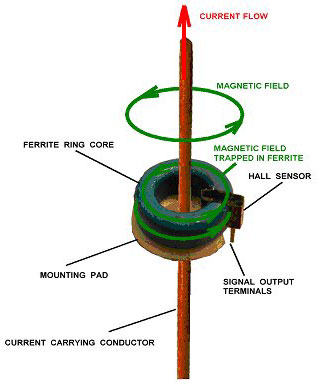Electricity and Magnetism - PatternAgents/Electronics_One_Workshop GitHub Wiki
I was hooked on electronics at a very young age, and one of things that always amazed me was the relationship between Electricity and Magnetism. It's as close to magic as electronics gets, and is the fun behind any amusement ride that you have ever been on.
- The basic idea here, is that when current{I} (i.e. electrons) flow though a conductor (i.e. wire) they generate a magnetic field, and the more current{I} that flows though the conductor, the larger the magnetic field generated.
-
The electric current{I} flowing through a wire creates a corresponding circular magnetic field outside the wire.
-
The direction of the magnetic field (clockwise-north pole or counter-clockwise-south pole) depends on the direction of the current flowing in the wire.
- It works the other way also, if a conductor (i.e. a wire) is passed through a magnetic field, then a current is induced to flow in that conductor. That's how your wireless phone charging pad works.

- When you make a coil of wire, by wrapping it around itself (air) or an Iron core, you create what we call an Inductor. Energy is stored in a magnetic field in the Inductor for only as long as current flows though it. When the current flowing through an Inductor stops, or changes, the collapsing (or expanding) magnetic field induces a voltage in the Inductor, according to Faraday’s law of electromagnetic induction. A large collapsing magnetic field in an Inductor can create a significant amount of current, in electronics, we often call that "flyback" or "kickback" and we often include circuitry to protect other electronics from damage from it.
The schematic symbol for an Inductor is :

- Making a coil of wire around an Iron core and passing a current through it creates an Electromagnet. These can be extremely powerful, large enough to lift tons of metal, even whole cars and buses.

- Electromagnets are also behind the operation of Relays. A Relay is basically an electrically operated switch. An Electromagnet is used to pull the switch contact of the Relay either on or off.

The schematic symbol for a relay shows the electromagnet as a box, operating a switch, where COM is the common connection, and NO means Normally Open, while NC means Normally Closed. The :

Sensing Magnetic Fields
- There are a number of different ways to sense and measure magnetic fields, the most simple being a coil of wire brought in close proximity to the magnetic field. These are referred to as Hall Sensors and they measure the current induced to flow in the coil of wire as a measure of the strength of the magnetic field surrounding the coil of wire.

The schematic symbol for a [Hall Sensor)() is as follows:

-
Hall Sensors are very useful for robotics and automation. For example any time you'd like a mechanical arm to travel only so far, you can place a magnet and a hall sensor at that location, and the signal from hall sensor can be used to stop the arm movement. Most laptops (or the older flip phones) use a hall sensor and magnet to know whether the lid is open or closed.
-
Why do we want to measure Magnetic Fields? There are a number of uses, including measuring the amount of current flowing in another wire, or what direction you are facing on the Earth. Yes, the Earth itself has magnetic field that we can measure, which is how the magnetic compass in your phone or your car works.

Ground Zero...
Which brings me to Ground, and I do mean literally, as the Earth is considered Ground.
In electronics, ground or earth is the reference point in an electrical circuit from which voltages are measured, a common return path for electric current, or a direct physical connection to the Earth.

Next ->
==================================================